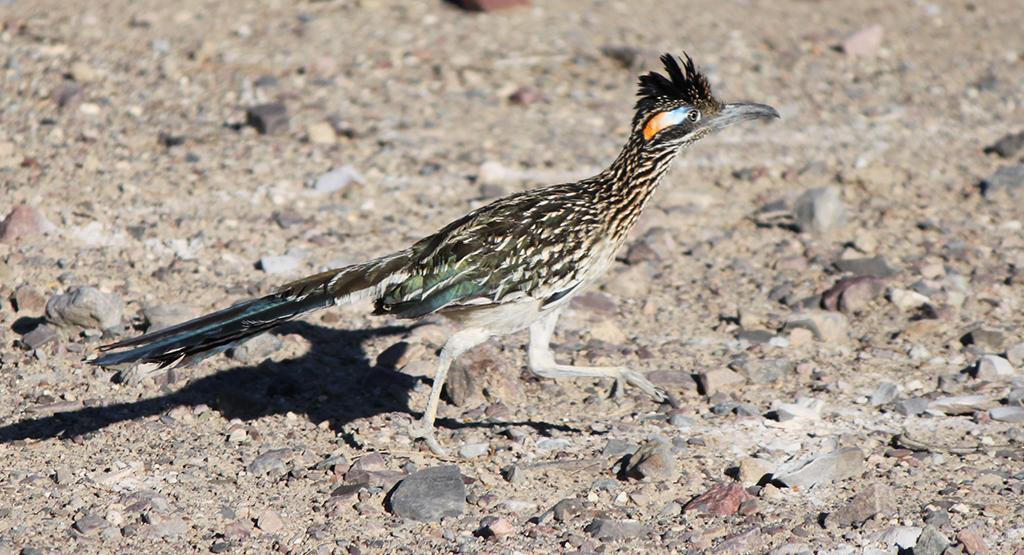Despite its inhospitable appearance, Death Valley National Park actually has quite a bit of life in its landscape.

One of the animals you are likely to spot is the coyote, Death Valley National Park / NPS file
One critter you might not want to encounter is a tarantula. The desert tarantula (Aphonopelma chalcodes) -- aka western desert tarantula, Arizona blond tarantula or Mexican blond tarantula -- is one of about 50 species of terrestrial tarantulas native to the southwestern and central United States.
This big spider's primary range includes arid portions of Arizona, New Mexico, Southern California, and adjacent parts of Mexico. Within this limited range it is actually very common, especially in open shrublands and sparse grasslands with dry, sandy, well-drained soils. Creosote bush scrub and Joshua tree forest are two examples of ecosystems that provide excellent habitat for desert tarantulas.
And then there's another unusual resident, the Devil's Hole Pupfish. This tiny fish lives in a 90-degree hot spring within a limestone cave located outside of the valley proper. The pupfish is something of an aquatic wonder, managing to live in a relatively small hot spring, one that denies them the ability to migrate up or down stream. Rather, they congregate in the spring, rising up to a small shelf of rock just beneath the water's surface both to feed and breed. Forty acres around the spring, which isn't actually within the formal borders of Death Valley National Park but rather off to the east, were set aside in 1952 to protect the hot spring and its inhabitants.
Of course, the park is home to more "traditional" wildlife, such as coyotes, bobcats, desert bighorn sheep, nine bat species, gophers, kangaroo rats, cottontails (mountain and desert), fox, badgers, ringtails, and even some mountain lions.
Bobcats gained attention back in December 2007 when there were two reported attacks by the medium-sized cats. In the first incident, on December 17th, a 64-year-old woman suffered scratches and bites on her hands, face, and scalp. In the second incident, on December 21st, a male employee of the inn had reportedly been smoking outside the building when the bobcat attacked him, inflicting bites and lacerations to his head and neck.
In both cases park officials attributed the attacks to improper food storage.
Burros also have been seen in the park in the past. These aren't natives, though, but rather "feral" burros thought to have been released into the wilds by prospectors who gave up. At one point not too many years ago it was thought that some 400 or 500 burros lived in the park’s 3.4 million acres of desert and mountain terrain.
You might be tempted to think that there’s room for half a thousand wild donkeys in 3.4 million acres, nearly all of which is federally protected wilderness, but this is simply not the case. As several writers have put it, the burros are “equina non grata.”
Back in the 1980s the NPS spent around $400,000 to build a burro-proof fence along 32 miles (51.5 km) of the park’s northeastern border. This ecological Maginot Line can scarcely be called a resounding success, since burros are still entering the western part of the park from BLM land and military bases.
It will eventually cost a small fortune to achieve the zero burros goal in Death Valley. The cost of capturing the animals is only the tip of the iceberg. Helicopters used for short hauling burros in remote areas set the NPS back about $1,000 an hour when all costs are factored in. Add in the cost of trucking, feeding, veterinary care, neutering, and adoption (handled through BLM), and the cost per animal is downright sobering.
Birding In Death Valley

Meep meep! Roadrunner zipping through Death Valley National Park / NPS file
Now, if you're in the right place at the right time and have a sharp eye, you might catch a glimpse of one of Death Valley's roadrunners. These fleet-footed birds are considered common in the park, and can be found year-round.
Birding can actually be quite rewarding in Death Valley, in spite of the landscape's appearance. Seek out some of the park's riparian areas, such as along Cottonwood Creek in Grapevine Canyon, along the Amargosa River along the park's border east of Furnace Creek, or where perennial springs offer nourishment. You can boost your odds by arriving during the spring or fall migrations, when hundreds of species have been seen passing through the park.
Birding hot spots identified by the Park Service include Saratoga Spring, Furnace Creek, Scotty's Castle, Wildrose, and the higher elevations of the Panamint Range where the mixed pinyon-juniper habitat attracts white-throated swifts, Lewis' woodpecker, mountain chickadees and other forest and broken-forest species.
You can learn more about the birds in Death Valley National Park by clicking here.





